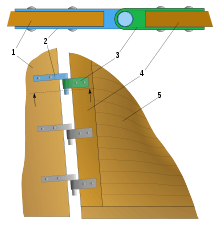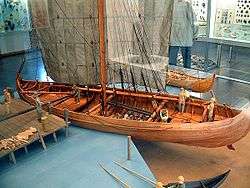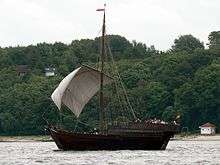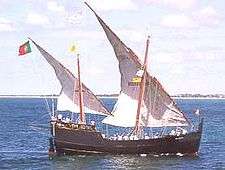Medieval ships

The ships of Medieval Europe were powered by sail or oar, or both. There was a large variety, mostly based on much older conservative designs. Although wider and more frequent communications within Europe meant exposure to a variety of improvements, experimental failures were costly and rarely attempted. Ships in the north were influenced by Viking vessels, while those in the south by classical or Roman vessels. However, there was technological change. The different traditions used different construction methods; clinker in the north, carvel in the south. By the end of the period, carvel construction would come to dominate the building of large ships. The period would also see a shift from the steering oar or side rudder to the stern rudder and the development from single to multi-masted ships.
Sailing ships
Early Middle Ages
Knarr

The knarr, a relative of the longship, was a type of cargo vessel used by the Vikings. It differed from the longship in that it was larger and relied almost entirely on its square rigged sail for propulsion.
High Middle Ages
Cog

Cogs were single-masted vessels, clinker-built with steep sides and a flat bottom [1]
Although the name cog is recorded as early as the 9th century,[2] the seagoing vessel of that name seems to have evolved on the Frisian coast during the 12th century.[3] Cogs progressively replaced Viking-type ships in Northern waters during the 13th century. Why this was the case is uncertain but cogs could carry more cargo than knarr of a similar size. Their flat bottoms allowed them to settle flat in harbour, making them easier to load and unload. Their high sides made them more difficult to board in a seafight, which may have made them safer from pirates.[4]
Cogs were also used as military transports and warships, fitted with towers fore and aft.
The cog traditionally reached the Mediterranean in 1304. This led to a Mediterranean variant, the cocha.[5]
Hulk
The hulk (OE:hulc) is first recorded in the 10th century, when it is distinguished from a keel (OE:ceol), a ship in keeled longship tradition such as the knarr. Although clinker-built, the distinguishing feature of hulks were that they had no stem or stern posts or deep keel, being flat bottomed like a cog. Early images of hulks show them strongly curved upwards at stem and stern.[6]
Hulks continued to be mentioned in use throughout the Middle Ages and into the 16th century, when it is particularly associated with the Baltic and the Hanseatic League. These late hulks could be as large as contemporary great ships. Jesus of Lübeck of 1544 was a ship of 700 tons, the same as the Mary Rose.[7] However, how similar later medieval hulks were to their ancestors is unknown. There is some evidence of a hybridisation with the cog form, showing both hulk and post construction.[8] Others have suggested that late hulks were partially carvel-built.[9]
Late Middle Ages
Caravel

The caravel was a ship developed by the Portuguese and used from the 15th century on for oceanic exploration voyages. Unlike the longship and cog, it used a carvel method of construction. It could be either square rigged and lateen rigged (Caravela Redonda) or only lateen rigged (Caravela Latina). The most famous examples of caravels were the Niña and the Pinta.
Carrack

The carrack was a ship type invented in southern Europe in the 15th century and particularly developed in Portugal in the same century. It was a larger vessel than the caravel. Columbus’s ship, the Santa María was a famous example of a carrack. The ships commanded by Vasco da Gama as the São Gabriel, with six sails, a bowsprit, foresail, mizzen, spritsail and two topsails, already had the complete features and the design of the typical carrack.
Small Vessels
A number of smaller vessels are named in English sources of the Late Middle Ages, some of which continued into the 16th century and beyond.
Crayer
A vessel of 20-50 tons, used largely on the cross channel trade[10]
Hoy
The hoy originated in Flanders in the 15th. century. A single-masted vessel usually of 25-80 tons used a coaster or on short sea routes, as well as a lighter. The type would evolve in the 16th and 17th, only finally disappearing in the early 19th century.[11]
Picard
First recorded in the 1320s, the picard was a single-masted vessel of 10-40 tons used mainly as support vessel for fishing fleets, bringing home their catches and ferrying supplies, or as a lighter, loading from vessels at anchor and discharging onto beaches or shallow creeks. A widespread type, in use from Scotland, all round the English coast and across in Ireland.[12]
Oared ships
Early Middle Ages
Galley
Galleys had been in use for trade and warfare since at least the 8th century BC and remained in use throughout the Middle Ages. Rowing was the primary method of propulsion, which was well-suited for often fickle winds of the Mediterranean, where they were primarily used. The galley was also used in the waters of Northern Europe, but to a lesser extent since its low freeboard and lack of stability in rough seas made it vulnerable.
Longship
The longship was a type of ship that was developed over a period of centuries and perfected by its most famous user, the Vikings, in approximately the 9th century. The ships were clinker-built, utilizing overlapping wooden strakes.
High Middle Ages
Balinger
The balinger was a clinker-built oared vessel, initially with a single mast but in the 15th century larger vessels had a second mast. They were usually small vessels of 40-60 tons but larger vessels of up to 120 tons are recorded. Balingers were popular in the Bay of Biscay and English Channel and were used both for trade and warfare. Fast and with the flexibility of oars and sails for propulsion, they were commonly used by pirates [13]
Late Middle Ages
Birlinn
In the waters off the west of Scotland between 1263 and 1500, the Lords of the Isles used galleys both for warfare and for transport around their maritime domain, which included the west coast of the Scottish Highlands, the Hebrides, and Antrim in Ireland. They employed these ships for sea-battles and for attacking castles or forts built close to the sea. As a feudal superior, the Lord of the Isles required the service of a specified number and size of galleys from each holding of land. For examples the Isle of Man had to provide six galleys of 26 oars, and Sleat in Skye had to provide one 18-oar galley.
Carvings of galleys on tombstones from 1350 onwards show the construction of these boats. From the 14th century they abandoned a steering-oar in favour of a stern rudder, with a straight stern to suit. From a document of 1624, a galley proper would have 18 to 24 oars, a birlinn 12 to 18 oars and a lymphad fewer still.
See also
Footnotes
References
- Bass, George F. 1972.A History of Seafaring: Based on Underwater Archaeology . Thames and Hudson Ltd, ISBN 0-500-01077-3
- Crumlin-Pedersen, O. (2000) To be or not to be a cog: the Bremen Cog in Perspective International Journal of Nautical Archaeology 29.2: pp230–246
- Davies, Jonathan (2005). The King's Ships. Leigh-on-Sea, Essex: Partizan Press. ISBN 1-85818-547-5.
- Friel, Ian (1995). The Good Ship. London: British Museum Press. ISBN 0-7141-0574-0.
- McGowan, Alan (1981). Tiller and Whipstaff:The development of the Sailing Ship 1400-1700. London: National maritime Museum. ISBN 0-11-290313-4.
- McGrail, Sean (1981). Rafts,Boats and Ships. London: National Maritime Museum. ISBN 0-11-290312-6.
- Rose, Susan (2013). England's Medieval Navy 1066-1509. Montreal & Kingston: McGill-Queen's University Press. ISBN 9780773543225.
Further reading
- Flatman, Joe (2009). Ships and Shipping in Medieval Manuscripts. British Library Publishing, ISBN 978-0-7123-4960-4
- Hutchinson, Gillian (1994). Medieval Ships and Shipping. London: Leicester University Press, ISBN 978-0-7185-0117-4
- S. McGrail: ” Medieval boats, ships, landing places” in Waterfront archeology in Britain and Northern Europe, pp.17-23, Council for British Archeology, 1981.
- Gardiner, R & Unger, Richard W. (1994). Cogs, Caravels, and Galleons. Conway Maritime Press, ISBN 1-55750-124-6